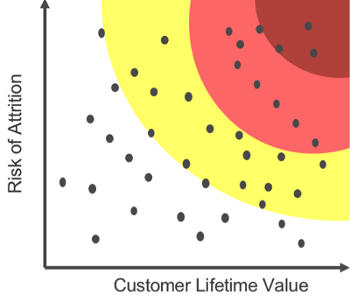Have you ever had an irrelevant ad follow you around the Internet for a week? Or did you try to buy something online but checkout was too much of a pain? Or you clicked a link only to land on information different from what you expected to see?
Customers today are used to brands disappointing them online. That's why the vast majority of marketing emails are ignored, along with the majority of carts being abandoned and mobile apps being uninstalled.
Know your customers so you can differentiate and improve their journeys
Typical Web analytics data focus on your digital properties (like unique clicks on an ad or bounce rate on a page). Data like those are table stakes for brands conducting e-commerce because they provide insight only into what is happening in your digital universe.
Customer data, however, will tell you why your digital properties perform as they do, for better or worse. And when you know what and why, you know what to do to make your customers' journeys better.
Customer data focuses not on your digital properties directly but on the users interacting with them. And today, in the age of AI-powered marketing, how you use your customer data to improve your digital marketing can give you an edge over the competition.
How? By using your knowledge of the customer to create experiences along the journey that she will value, that will keep her progressing—and bring her friends along with her. That is how you go from disappointing customers to making customers happy. That is how you turn prospective customers into loyal advocates for your brand.
Understand types of customer data and how to use them
Let's explore a few categories of customer data that have the potential to have a positive impact on your customer journeys in the near term.
Mindset Data
What's the difference between a customer who has only recently heard of your brand and a customer who has long been a hardcore devotee? Maybe a lot of things, but one thing that's likely different is their mindset.
In the context of digital marketing, mindset changes as customers interact with your brand, become more engaged, and build a relationship. You can start to determine customer mindset by following customer activity (typically via data-capture solutions) and assigning a phase of the customer journey according to that activity.
Let's use retail as an example:

Once marketers segment customers by mindset, they can create experiences along the customer journey that help progress each mindset segment to the next phase. For example, if your customer is a Comparer, make sure he has the information he needs to assess your products in his consideration set. That could mean you send an outbound campaign, or maybe you tailor a Web experience that brings the appropriate information to the foreground.
New AI-enabled solutions can automate and scale your ability to segment your customer base by mindset and market to them accordingly. Marketers who are still working manually shouldn't assume the customer will find the right content at the right time. The customer ultimately decides the journey; your job is to help them get from A to B to C.
Behavioral Data
How do your customers act on your digital properties? Surprisingly, many brands don't know how customers actually interact with the digital worlds the brands have invested so much in.
The simple use case for behavioral data is to make sure your customers are able to achieve their goals (such as finding info or conducting a transaction) on your websites and apps. In the absence of behavioral data, some analysts make inferences based on classic Web analytics. For example, if customers are overusing your search function, your navigation may be lacking.
However, marketers can glean such info with more speed, accuracy, and dependability by using behavioral analytics solutions that capture and display customer data—such as session replays, heatmaps, and usability analytics—that show the customer experience from the customer's perspective, whether in aggregate or individually.
Heatmaps, for example, tell you exactly which parts of the page customers focus on, scroll to, click on, or even mouse over, providing a visually direct way of assessing how your site or app is used in aggregate.

For an individual customer-level view, you can't get much closer to the actual customer experience than watching a session replay. Let's say a widget on your site is showing low engagement. Watching a few replays of widget sessions can show any issues affecting it that may be deterring users (such as a slow load time or browser compatibility issue).
Behavioral analytics solutions, like many digital marketing solutions, have increased immensely in value to marketers with the addition of AI. For example, marketers can receive alerts proactively when certain areas of sites and apps demand immediate attention, such as missed conversion opportunities or customer struggles. The result is the ability to identify and prioritize modifications that can have big impact on performance.
Engagement and Value Data
Entire digital forests have been felled to harvest enough PDF pages for all the whitepapers that have been written on calculating customer value. You can wade into the deep, confusing jungles of customer value management, or you can...
- Leave it to the Finance department to figure out.
- Use AI solutions that make these calculations for you, at speeds and accuracy levels that a building full of data scientists couldn't replicate alone.
- Create simpler, if less accurate and effective, models based on available customer data around value, recency, latency, and frequency of purchases and general engagement. (You can even find free calculators out there with a quick search.)
Of course, we wouldn't be putting you through the trouble of making these assessments if they weren't actionable in driving marketing ROI.
Imagine your customers are scattered as on the chart below. It gives a pretty clear indication of where to prioritize your marketing spend, doesn't it? The top-right is Code Red: Those customers are worth a lot to your business and are likely to churn. Let's send them an aggressive offer to get them back on the site. Once they convert, let's target them with another offer to re-establish their buying cadence. Then let's invite them to a user community to get them engaged. Essentially: Let's tailor a high-impact customer journey to this segment based on what we know about them.

But where do the resources for tailoring these journeys come from? Out of your overflowing marketing budget? Just kidding. Instead, an analysis like this will let you know which customers you can think about shifting resources away from, like those on the bottom left, who are worth less to your business.
Journey to a better digital world
Despite advances in customer data capture and tools enabling brands to use it, customers often remain disappointed in the online experiences that brands create. But that disappointment poses a great opportunity for brands to create journeys that customers actually value rather than avoid or just tolerate. Customers value journeys that address their unique circumstances, and we can't win in the marketplace unless our customers win by coming along with us.
Explore how you can build and analyze the most effective customer journeys to find the quickest paths to conversions with this interactive demo.




